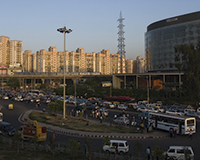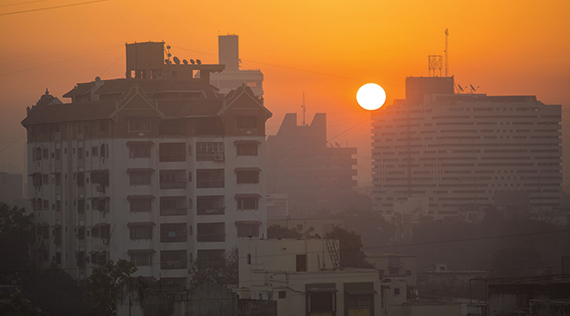For investors willing to move up the risk curve, some of India’s secondary cities could be a lucrative proposition, writes Sophia Furber
Investing in second-tier cities requires a significant leap of faith. Leaving the bright lights and familiarity of a capital or major global hub to make a foray into the relatively unknown means taking a step up the risk curve. This is true no matter where you are in the world, but in India the risk is likely to feel all the more pronounced.
The country has a staggering 46 cities with a population of more than 1m. This compares with just 35 across the whole of Europe. The number of urban middle-class households stands at 22m but could soar to 91m by 2025, according to a study by the McKinsey Global Institute – and much of this growth will come from emerging cities.
The report predicts that the composition of the world’s top 600 cities, which account for more than 60% of global GDP growth, is set to change radically by 2025, with a number of developed-world cities dropping away to be replaced by 136 new entrants. All of these are from the developing world, and 13 will be from India, including Surat and Ahmedabad.
After storming the polls in the May general election, India’s new prime minister Narendra Modi appears to have recognised the potential opportunities that lie beyond the country’s traditional hubs. In his debut budget in July, Modi announced plans to develop 100 “smart cities” across India. The idea is to spread the gains of India’s economic development outside the seven main cities of Mumbai, Bangalore, Pune, Kolkata, Chennai, Hyderabad and Delhi – where all but 15% of India’s commercial development is concentrated.
So, could India’s vast array of second cities be the best investment opportunities the UK property industry has never heard of? Where exactly are the hot spots outside of the better-known hubs of Mumbai and Delhi? And what sort of opportunities and returns are up for grabs to cushion that leap of faith?
Manchester of the East
Ahmedabad is a good place to find out. The city, considered second-tier, is the largest in Gujarat, a state in the north-west of the country that contributes 7.5% to India’s GDP and has 30% of the country’s stock market capitalisation. It also has a special place in Indian politics; not only was it a base for Mahatma Gandhi during key years of the Indian independence movement, but prime minister Modi spent 10 years as chief minister of Gujarat prior to May’s election.
It is a city that was once known as “the Manchester of the East” because of its creative importance and global textiles industry. Now it is finance, manufacturing and services that drive the economy in Ahmedabad.
“We have a strong culture of entrepreneurial and family-run businesses, and they tend not to have large requirements for office space. However, we have started to see more demand from financial services companies and telecoms in recent years,” says Anup Shah, general manager of CBRE’s Ahmedabad office.
The city has a handful of large international corporate tenants, among them US data and news company SNL Financial, which occupies around 150,000 sq ft after setting up a base in the city in 2006.
Shah is hopeful that more multinationals will follow SNL’s lead. US marketing materials company Vistaprint signed a lease for around 50,000 sq ft in July, and Shah predicts the next crop of international tenants are likely to be banks.
Gujarat has a particularly close economic relationship with Japan. Some 60 Japanese companies operate in the state, according to a September speech by Japanese ambassador to India Takeshi Yagi. Car maker Maruti Suzuki is planning to develop a $485m (£309.6m) manufacturing plant near Ahmedabad, and Honda is considering setting up its third Indian automotive plant in the vicinity. Shah anticipates that this activity will generate demand from corporate banks for small or mid-sized offices in Ahmedabad to cater to the region’s rising numbers of multinationals.
This is already starting to feed through in the office market, where absorption was 1.1m sq ft between January and the end of September this year – a threefold increase on the same period in 2013, according to Cushman & Wakefield.
“New cities are absolutely the need of the hour. As a country we need to take the pressure off our major metropolitan areas. They are already strained to breaking point.”
Smart moves
Ahmedabad is also the site of India’s first smart city – Gujarat International Financial Tech City. The $11bn government-backed project will include 62m sq ft of commercial and residential space in a 250-acre special economic zone.
The government of Gujarat is aiming big with GIFT, which it hopes will lure will major financial occupiers away from Mumbai, Bangalore and Delhi and employ as many as 500,000 people.
At last month’s Municipalika, India’s largest convention for sustainable urban development, there was a huge buzz around the potential impact of the smart city plans. Attendees at the two-day event just outside Ahmedabad included property developers, housing associations, and tech firms peddling a mind-boggling array of wares designed to improve urban living, ranging from talking LED lamp posts to waste management systems made from giant terracotta pots.
“New cities are absolutely the need of the hour,” says Ambadas Bhore, who travelled from Mumbai to represent Cybertech, a company providing GIS technology to planners and developers. “As a country we need to take the pressure off our major metropolitan areas. They are already strained to breaking point.”
CBRE’s Shah is also in favour of smart cities. “Conceptually, GIFT is fantastic, but execution will take a long time. Modi’s strong track record over the past decade indicates that he will be able to deliver on infrastructure,” he says.
Manish Bhandari, chief executive of Mumbai-based discovery fund Vallum, adds: “What Modi has done so far with Ahmedabad’s infrastructure is impressive. It is a state with a good governance structure.”
One to watch
Gujarat is not the only region to benefit from Modi’s initiative. In October, the prime minister signed a deal with Barrack Obama to enlist US support to develop three smart cities in Allahabad, Ajmer and Vishakapatnam (also known as Vizag).
“Vishakapatnam in Andhra Pradesh is one to watch,” says Knight Frank India’s head of office leasing Viral Desai.
The southern city has a population of around 1.7m
and has received a deluge of interest from international investors this year. Not only is Vishakapatnam due to be redeveloped as a smart city, but AIM-listed Bollywood film distributor Eros International signed a memorandum of understanding with the government of Andhra Pradesh in November to develop a £6bn media city there. This would include TV and film production studios, offices, shops and a Bollywood theme park.
Japanese residential developer Tama home has also chosen Vishakapatnam as the site of its first foray into the Indian market, in partnership with local company Developer Group India Private. Tama plans to develop homes on a 50-acre site with a view to launching in January.
Part of the reason behind Vishakapatnam’s ascendancy, Desai points out, is to do with a recent political change that has led to an overhaul of the state boundaries. Telengana, India’s 29th state, was carved out of Andhra Pradesh at the beginning of June, taking Hyderabad, a city of more than 8m people, with it. This means that Vishakapatnam is now the state’s largest city by both population and economy, and thus an important location for state-level corporate headquarters.
At the time of going to print, Vishakapatnam was awaiting news of whether it would be chosen to host an Indian institute of management as part of a tie-up with its existing university. India’s 13 existing IIMs are among the best management schools in the country, if not the world. The Kolkata IIM’s finance department topped the FT rankings for global business schools last year, beating the London School of Economics and Manchester Business School. Crucially, from a property perspective, IIMs are viewed by multinationals as a key source of talent.
Tier-two timing
There is clearly a government drive in India to elevate and develop new areas. But how do India’s blue-chip developers view tier-two cities? Kamal Khetan, chief executive of Sunteck Realty, a listed Indian developer that counts TIAA-CREF and BNY Mellon among its shareholders, believes there are good opportunities for development in second-tier cities as long as investors are selective. The bulk of Sunteck’s investments are concentrated in Mumbai, but the developer’s portfolio includes properties in other states, such as a 130,000 sq ft business park in Panji, the state capital of Goa. Tenants include KPMG.
“Tier-two cities need to have a story that investors can believe in. In Bangalore, it was IT. For example, it could be textiles and diamonds in Surat, or logistics in a centrally located city like Nagpur,” he says.
Khetan advises property investors to only focus on grade-A buildings in regionally dominant towns and cities.
For those for whom second-tier cities are a step too far, there is an interim option. Surabhi Arora, Delhi-based head of research at Colliers International, says the real estate world would do well to watch out for opportunities in satellite towns and cities on the fringes of metropolises such as Mumbai and Delhi.
The satellite town is a particularly Indian phenomenon. These large urban areas are semi-independent from the major cities they orbit, functioning as dormitories for middle-class commuters, but also emerging as economic centres in their own right.
“Navi Mumbai and Thane on the outskirts of Mumbai, and Gurgaon/Noida in the Delhi region are doing really well and are very appealing for business process outsourcing occupiers,” says Arora.
Indeed, Colliers’ data shows that office rents for Navi Mumbai appreciated by 23% year-on-year to Rs60-100 (62p-£1.03) per sq ft per month in Q3. This compares with flatlining rents in Bandra Kurla Complex, one of Mumbai’s most sought-after office locations, which have held steady at Rs225-300 per sq ft for the past year. Gurgaon also had a good third quarter, with office take-up double the Q2 figure at 1m sq ft, of which 70% was from the IT sector.
Urbanisation in India, and in emerging markets at large, is one of the most important global megatrends for international business and commercial real estate. From the perspective of property investment in India, for a brave few the time is ripe to take that leap of faith into the second-tier cities being backed by government. For those who worry it might still be a bit premature to be buying that business park in Thiruvanthapuram, the next five years will prove crucial if they want to limit the risk without missing the boat.
sophia.furber@estatesgazette.com












